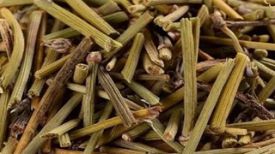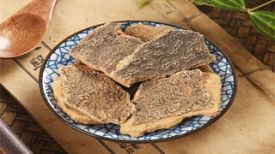
1. Aliases
Su Fang, Su Fang Mu, Brown Wood, Crimson Wood, Red Chai, Red SuMu.2. Plant morphology
Shrubs or small trees, 5-10 meters high. The trunk has thorns, and when new branches are young, they are covered with fine soft hairs, with protruding circular pores. Compound leaves alternate, 7-13 pairs, 6-15 centimeters long, with pubescence on the leaf axis. Leaves 9-17 pairs, oblong, 0.5-1.5 cm long, approximately 0.5 cm wide, initially obtuse or slightly concave, entire, hairless on both sides, with glandular dots below, base truncate. The panicle is terminal or axillary, almost as long as the leaves, covered with short pubescence. The flowers are bisexual, with a 5-lobed calyx and a smaller lower petal. The stamen is 10, and the upper part of the filament is thin and twisted, while the lower part is thicker and densely covered with fine woolen hairs. The female flower is 1. The style is slender and shorter than the stamen, and the ovary is superior. It is ovate lanceolate, slightly flattened, covered with gray hairs, and is 1-chambered. Pods, flattened obliquely obovate, thick leathery, 6-10 cm long and 3-4 cm wide, mature in reddish brown color and not cracked. Seeds 3-5, elliptical or elongated. The flowering period is from April to June, and the fruiting period is from August to November.
3. Origin distribution
Born on flat land with high temperatures, humidity, and abundant sunlight. There is wild distribution in the Jinsha River Valley and Honghe River Valley in Yunnan, China, and cultivation is found in provinces and regions such as Yunnan, Guizhou, Sichuan, Guangdong, Guangxi, Fujian, and Taiwan.
4. Harvesting and processing
Harvest in autumn, remove white sapwood, and dry.
5. Characteristics of medicinal herbs
It is in the shape of a long cylinder or a half cylinder, with a length of 10-100 centimeters and a diameter of 3-12 centimeters. The surface is yellow red to brownish red, with knife marks and common longitudinal cracks. Hard texture. The cross-section is slightly glossy, with obvious growth rings, and some can see dark brown, loose, and bright starry pith. Mild Qi, slightly astringent taste.
6. Nature, taste, and meridian tropism
Mild in nature, sweet and salty in taste. Guixin Meridian, Liver Meridian, and Spleen Meridian.
7. Effect and function
Promoting blood circulation and removing blood stasis, reducing swelling and relieving pain. Blood activating and pain relieving drugs belonging to the subcategory of blood activating and stasis removing drugs.
8. Clinical applications
Internal administration: 3-9 grams, boiled in water. Used to treat injuries caused by falls and injuries, fractures and tendons, stasis and swelling, amenorrhea and dysmenorrhea, postpartum stasis and obstruction, chest and abdominal pain, and abscess and swelling.
9. Pharmacological research
It can affect the circulatory system, affect blood viscosity, and has certain anti-cancer effects, as well as hypnotic and antibacterial effects.
10. Chemical composition
Heart wood contains chromogenic alkanes. It also contains Brazilian hematoxylin, oxidized Brazilian hematoxylin, 3 '- O-methylBrazilian hematoxylin, and derivatives of Brazilian hematoxylin 1 and 2. It also contains dibenzoepoxyheptane compounds, hematoxylin J, P, octacosanol, β - sitosterol, and dandelion sterol.
11. Taboos for use
It should be used with caution for those with scattered blood, blood deficiency without stasis, and pregnant women.
12. Compatibility prescription
① Treating postpartum dizziness: 90g of cork, crushed, five cups of water, boiled in two cups, mixed with a small amount of alcohol, divided into two servings. (Hygiene Simplified Formula)
② Treatment for falls and injuries, stroke due to sores: Su Mu (mallet rotten, grind) 60g. Take two liters of wine, fry one liter, and divide into three servings, one for hollow, one for noon, and one for night lying. (Su Mu liquor in the "Shengji Zonglu")
③ Treatment of rheumatoid arthritis: 30g of cork tree trunk. Boiled in water. (Selected Guangxi Materia Medica)
④ Treatment for swelling and pain caused by falling: 90 grams of Su Mu, a pot of good wine. Cook and drink frequently. ("Bianhu Ji Jian Fang")
⑤ Treatment for cervical cancer (Qi stagnation and blood stasis): 10g of SuMu, 30g of BanZhuanggen, 30g of XiaohongShen, 15g of XiangFu, and 15g of Verbenaceae. Boiled in water. (Yunnan Anti Cancer Chinese Herbal Medicine)
The content of the article is for clinical reference only. Non professionals in traditional Chinese medicine are not allowed to try medication.
7. Effect and function
Dispelling wind and dampness, unblocking meridians, and promoting urination. Belonging to the subcategory of dispelling wind and dampness, it is a strong muscle and bone medicine for dispelling wind and dampness.
8. Clinical applications
Dosage 6-12 grams, take water decoction or water decoction with yellow wine. Wipe the painful area with external water decoction. Used to treat rheumatism, joint swelling, paralysis, and itching. Pharmacological experiments have confirmed that it has analgesic, sedative, anti-inflammatory, and anti allergic effects. The effects on the cardiovascular system are manifested in various aspects, such as anti arrhythmias, anti myocardial ischemia, and blood pressure lowering.
9. Pharmacological research
Analgesia, sedation, cough suppression, anti-inflammatory, antihypertensive, immunosuppressive, antiarrhythmic, anti myocardial ischemia, protective against reperfusion injury, blocking ganglia and neuromuscular transmission, releasing histamine, reducing myocardial contractility, and inhibiting adrenaline induced automaticity; It has an excitatory effect on the gastrointestinal tract, but also has mild gastrointestinal adverse reactions and other effects.
10. Chemical composition
It mainly contains various alkaloids such as sinomenine, sinomenine, tetrandrine, matrine, N-demethyltetrandrine, and dicyanidine, as well as components such as racemic eugenol and acetyl oleanolic acid.
11. Taboos for use
Side effects such as pain, itching, rash, dizziness and headache, skin redness, abdominal pain, chills and fever, allergic purpura, thrombocytopenia, and leukopenia may occur. Attention should be paid when using.
12. Compatibility prescription
① Treatment of rheumatism and pain: 15 grams each of Qingfengteng and Hongteng. Boil in water and add an appropriate amount of wine to drink; Or 30-60 grams of Qingfengteng, 3 grams of Guizhi for upper limb pain, and 6 grams of Niugeng for lower limb pain. Use all three ingredients for body pain, boil in water, add an appropriate amount of yellow wine, and take after dinner. (Zhejiang Medicinal Flora)
② Treating joint pain: 15 grams of green vine and 15 grams of red vine. Boiled in water, once a day. Wine serves as a guide. (Shaanxi Chinese Herbal Medicine)
The content of the article is for clinical reference only. Non professionals in traditional Chinese medicine are not allowed to try medication.


